Sat 10 Oct 2020
Family Visits, Spring and Summer 2020
Posted by Bob under Family and Friends, Hiking/Sauntering, Nature, Vegetable Garden
No Comments
Sat 10 Oct 2020
Posted by Bob under Family and Friends, Hiking/Sauntering, Nature, Vegetable Garden
No Comments
Wed 4 Jul 2018
Posted by Bob under Vegetable Garden
No Comments
I like to experiment with different varieties of garlic; this year I planted Inchellum Red (from stock from last year’s harvest), Music, and Georgian Fire (mail ordered from a supplier in Maine). Planting of garlic cloves takes place in the fall, generally September. Presumably because of our rainy and cloudy spring, the plants matured more slowly than usual, and so harvest didn’t take place until July 3rd, several weeks later than usual. Several dozen onions I’d planted were also pulled. All are now curing in the kennel outbuilding. Curing usually takes about one to two months, although one can “cheat” at any time for fresh pesto and other summer delights.
By late July, this Rampicanti Zucchini Squash weighed 15 pounds and was 48 inches long! It will disappear into many loaves of zucchini bread!
Sat 25 Nov 2017
Posted by Bob under Family and Friends, Travel, Vegetable Garden
No Comments
We had a colorful fall, although a quite dry one. I planted seeds for a fall vegetable garden at the end of August, and within a month or so was rewarded with plenty of lettuce varieties, arugula, chard, collards, and kale. Kale and collard quiches became a standard part of our diet for the next two months.
With two local friends, Holly and I spent a weekend in the old railroad town, Clifton Forge, in the Allegheny Highlands, enjoying the C&O railway museum and the German-style Christmas market as well.
Back home, we celebrated Thanksgiving with Holly’s son John, sister Constance, sister-in-law Lonni, and Tim and Megan. And assorted dogs… And we skyped with Felix and his parents in Mobile!
 Â Â
  
Mon 24 Jul 2017
Posted by Bob under Farms and Food, Vegetable Garden
No Comments
We had a very wet spring, to which Holly and I attribute much of the success of our summer vegetable garden. Varieties of greens (lettuce, arugula, swiss chard, broccoli rabe, kale) flourished in the spring, and garlics, onions, several varieties of string beans, zucchini, cucumbers, peppers, lima beans, basil, and tomatoes galore filled the garden in the summer, even if we’ve had to share the tomatoes with crows and rabbits (and maybe a groundhog). Spaghetti squash, watermelon, and cantaloupe are in the works. I was more disciplined this year about succession planting, especially for beans, and that has kept us well supplied over time. The one virtually total crop failure was snap peas, long my favorite and most prolific crop. But this year almost none germinated, and only a handful of snap pea pods ever appeared. I have spoken to several other growers who had a similar experience. No one fully understands why this should be; it will be interesting to see what happens next year. Overall, though, one of our best years in the garden.
click here for pictures of our 2017 vegetable garden
Sun 2 Jul 2017
Posted by Bob under Hiking/Sauntering, Nature, Vegetable Garden
No Comments
Another trip up Humpback Rocks, this time with Dan Moler. A beautiful day! On a hike there two weeks earlier, Sue Rucker and I got to watch a bear calmly foraging.
Looking at the view to the east from the Blue Ridge Parkway
Having a tree in our front yard taken down (it was shedding large limbs onto the street) revealed multiple snakes living in the hollowed out trunk and limbs. It also enhanced the view from our living room window quite spectacularly.
Back in the vegetable garden, the two types of garlic I grew this year, Inchellium Red and Music, were pulled and laid out to cure in mid-June. 42 bulbs total.
By the beginning of July, our many varieties of lettuce were beginning to bolt, but we’d been regularly harvesting kale, chard, arugula, and other greens for some time, along with a first crop of wax beans, cucumbers, zucchini (enough for six loaves of zucchini bread so far), yellow squash, and a few ripe tomatoes and peppers.
Mon 3 Aug 2015
Posted by Bob under Flower/Rock Gardens, Vegetable Garden
No Comments
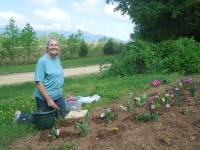 Â
 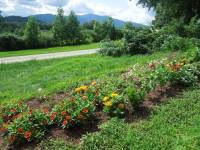
Holly added a flower garden below the veggie one
It was a good year for flowers–plenty of rain, enough sun, not too hot. But things were more complicated in the vegetable garden, with alternating long periods of dryness and continuous rains that upended its usual flow. Tomato hornworms decimated our tomato plants, and Japanese and Mexican bean beetles did in a good part of the later-developing string bean crop and all of the lima beans. An early dry spell made our snap peas tougher and less plump than usual and a later one put an end to originally-promising cucumber and squash production. Extreme wetness in June appears to have wrought extensive rotting in what looked otherwise like a very promising garlic crop. As a former teacher used to grading, I would say it was a C+ year. We were able to enjoy some fresh vegetables and to give and can and freeze some away, but at a level well below the norm of previous years. But the flower gardens bloomed nicely through spring and summer.
Wildlife remained plentiful
Summer’s Bounty
This year’s best new crop award: “Cute Stuff Bell Peppers”
(amazingly early and prolific)
Thu 28 Aug 2014
Posted by Bob under Flower/Rock Gardens, Vegetable Garden
No Comments
The weather this summer was unusually cooperative, and pest problems were far less than last summer, when it rained almost every day. Beans were our number one crop: so many bushels that we gave many away after filling much of the freezer with parboiled beans. Squash and tomatoes were plentiful; onions, garlic, peppers, cucumbers, and potatoes did reasonably well, although I had to toss out the late-season potatoes because of extensive pest damage. Mexican bean beetles did in the lima beans late in the season. Parsley and basil grew in abundance, and there are many bags of spring snap peas in the freezer (and still getting some turnips and chard planted in the spring).  Overall, a good harvest with lots of good eating!
Holly canned mixed pickles with veggies from both the garden and from the local farmer’s market. She planted a variety of vegetables in her garden at her Lake Monticello home; brussel sprouts and others are coming along.
Flowers and a new friendship bloomed nicely as well!
Wed 4 Jun 2014
Posted by Bob under Vegetable Garden
No Comments
Lots of snap peas, lettuce, herbs (especially cilantro and parsley), collards, and turnips ready for harvesting; potato plants beginning to flower; garlic scapes emerging on hardneck garlics; tomato and pepper plants beginning to flower. Multiple varieties of bush and pole beans growing nicely. No problem with pests…..yet.
Tue 17 Sep 2013
Posted by Bob under Vegetable Garden
No Comments
Our unusually wet summer continued through the month of August, bringing with it the worst Mexican bean beetle and squash bug plagues I’ve ever experienced. After the initial harvests of bush beans, these pests did in my several varieties of pole beans and my several varieties of cowpeas. A plague of rabbits didn’t helped things either. Weeds were more aggressive this summer than ever before, and by late August the garden was a rather sorry sight.
But the late season Kennebec potatoes did well. Although slightly damaged by wireworms and white grubs, we did manage to harvest about fifty pounds of Kennebecs, bringing the total potato harvest to something over 120 pounds. The Thelma Sanders heirloom acorn squash were very prolific (the middle picture above shows about a third of the harvest). And I’ve just begun to dig up sweet potatoes, a new crop for me. I grew two heirloom varieties, Chesapeake and Continental Red, from Sand Hill Preservation Center in Iowa, a source, believe it or not, of over 200 heirloom varieties of sweet potatoes alone.
Sat 13 Jul 2013
Posted by Bob under Farms and Food, Vegetable Garden
No Comments
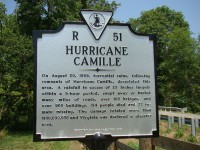 Everybody around here agrees it has been a very strange summer. Rain, generally in short supply this time of year, has been almost continuous, with downpours just about every day, frequently for many hours on end. I asked a long-time resident a few nights ago if she could recall a previous summer like this, and she answered: “1969.” That of course was the year that Hurricane Camille devastated an already-soggy Nelson County, with estimates of the rainfall in a single night varying from 27 to 46 inches. By contrast, our 5.5 inches later that night seems like nothing, but it was enough to cause substantial flooding, power outages, and flattened cornfields in the area.
Everybody around here agrees it has been a very strange summer. Rain, generally in short supply this time of year, has been almost continuous, with downpours just about every day, frequently for many hours on end. I asked a long-time resident a few nights ago if she could recall a previous summer like this, and she answered: “1969.” That of course was the year that Hurricane Camille devastated an already-soggy Nelson County, with estimates of the rainfall in a single night varying from 27 to 46 inches. By contrast, our 5.5 inches later that night seems like nothing, but it was enough to cause substantial flooding, power outages, and flattened cornfields in the area.
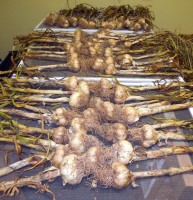 In mid-June I pulled around 95 garlic bulbs, grown from individual cloves planted last fall. This year I grew almost entirely softneck garlic. In some ways I prefer hardnecks, with their garlic scapes and (perhaps) more complex taste, but they don’t store well for more than a few months. The harvest looks good so far; the bulbs are curing on screens in our (former) kennel outbuilding.
In mid-June I pulled around 95 garlic bulbs, grown from individual cloves planted last fall. This year I grew almost entirely softneck garlic. In some ways I prefer hardnecks, with their garlic scapes and (perhaps) more complex taste, but they don’t store well for more than a few months. The harvest looks good so far; the bulbs are curing on screens in our (former) kennel outbuilding.
Seed potatoes were planted in mid-March and so far I’ve harvested 35 pounds of Yukon Golds and 36 pounds of Red Pontiacs. We’re already enjoying them. Kennebecs, a late season variety, are still growing and will be dug up later in the summer.
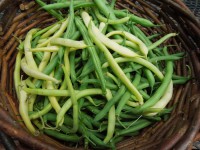 We’ve harvested quite a few bush and pole beans, but after two weeks or so, the dreaded Mexican bean beetle (and especially its larval form) went to work on both, in addition to our other legumes. By now they have pretty much decimated all our string bean plants, as well as the lima bean plants as well. Dry beans and cowpeas are also suffering from the onslaught, although I’m hopeful they will survive ok. There seems to be a general consensus that the been beetle infestation is particularly severe this year because of the combination of a mild winter and a wet spring and summer. (In contrast, I have not seen a single Colorado Potato Beetle this year.)
We’ve harvested quite a few bush and pole beans, but after two weeks or so, the dreaded Mexican bean beetle (and especially its larval form) went to work on both, in addition to our other legumes. By now they have pretty much decimated all our string bean plants, as well as the lima bean plants as well. Dry beans and cowpeas are also suffering from the onslaught, although I’m hopeful they will survive ok. There seems to be a general consensus that the been beetle infestation is particularly severe this year because of the combination of a mild winter and a wet spring and summer. (In contrast, I have not seen a single Colorado Potato Beetle this year.)
Currently we’re getting a steady flow of cucumbers and summer squash, although when 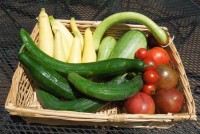 the sun really returns that will be more likely be a tidal wave. Tomatoes, whose development has been held up by the wet and cloudy weather, are finally beginning to ripen, as also our (still-green) peppers. Lots of butternut and acorn squash are coming along, as well as sweet potatoes (a new crop this year).  It adds up to a mixed score card, but overall the garden is doing pretty well. If only we could get a bit more sun….
the sun really returns that will be more likely be a tidal wave. Tomatoes, whose development has been held up by the wet and cloudy weather, are finally beginning to ripen, as also our (still-green) peppers. Lots of butternut and acorn squash are coming along, as well as sweet potatoes (a new crop this year).  It adds up to a mixed score card, but overall the garden is doing pretty well. If only we could get a bit more sun….
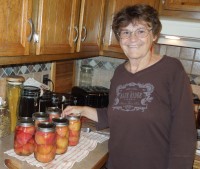 We’re also benefitting from nearby farms and farm markets. We’ve picked strawberries and blueberries at Seaman’s Orchard, with its gorgeous view of the mountains in both Nelson and Amherst Counties.  Our favorite peach, Sugar May, came into season recently at Saunders Brothers, and Monika canned six quarts. The fresh flavor holds up amazingly well.
We’re also benefitting from nearby farms and farm markets. We’ve picked strawberries and blueberries at Seaman’s Orchard, with its gorgeous view of the mountains in both Nelson and Amherst Counties.  Our favorite peach, Sugar May, came into season recently at Saunders Brothers, and Monika canned six quarts. The fresh flavor holds up amazingly well.